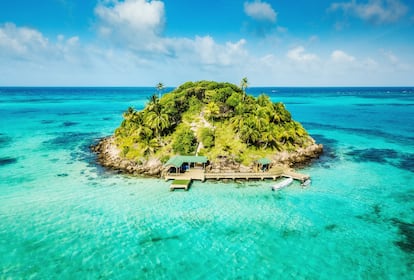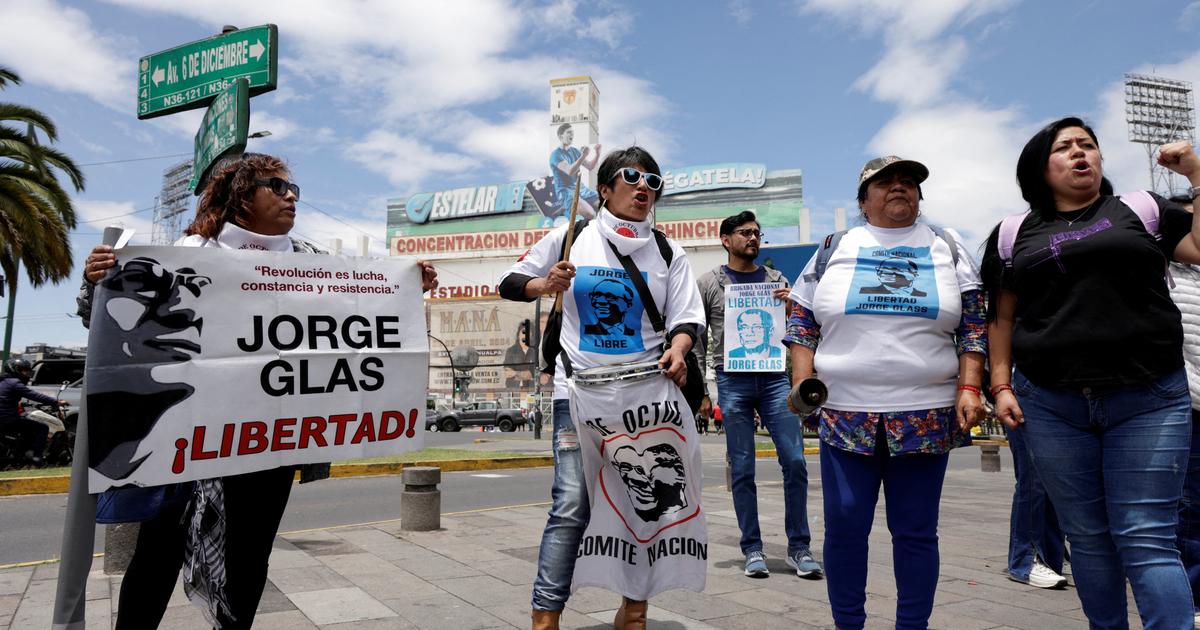An island in the San Andrés archipelago, which is part of the Seaflower Biosphere Reserve. Erick Lucio / EyeEm (Getty Images / EyeEm)
In the heart of the archipelago of San Andrés, Providencia and Santa Catalina there is an ecosystem of around 180,000 km2 that has one of the largest coral reefs in the world, more than 407 species of fish and 157 species of birds.
In 2000, UNESCO declared this area a Biosphere Reserve, an ecosystem of great environmental importance whose function is to harmonize the conservation of biodiversity and the sustainable development of the surrounding communities.
Seaflower is the largest Biosphere Reserve of the five in Colombia and is twice the size of Portugal.
But this paradise was divided and its conservation at risk due to the ruling of the International Court of Justice (ICJ) in The Hague in 2012, which partially resolved the border dispute between Colombia and Nicaragua.
The ICJ granted the Central American country 75,000 km2 of sea in which Colombia had exercised sovereignty until then, including part of Seaflower.
That decision and the disputes that continue between the two countries keep the communities that have historically inhabited the area in uncertainty.
They also keep the Great Seaflower initiative in suspense, a conservation project that proposes expanding the Reserve to 500,000 km2 as a cross-border reserve of six countries (Colombia, Costa Rica, Honduras, Jamaica, Nicaragua and Panama) that would manage it with the support of scientists. and local communities.
This would promote ecological connectivity and articulate the efforts of the countries of the southwestern Caribbean to protect the most representative marine and coastal ecosystems in the area.
For Mateo Córdoba, coordinator of the initiative and part of the Franz Weber Foundation, advancing in the conservation of this ecosystem cannot be postponed: “The Reserve has three serious problems: intensive tourism, overfishing and other problems associated with climate change.
The Caribbean is a time bomb, hurricanes and coral bleaching are proof of that.
That is why it is urgent that in order to solve them a dialogue be established and coordinated between the six countries that are part of the Great Seaflower reserve.
There is a very valuable marine biodiversity here that you can not wait any longer.
A historic lawsuit
The debate between Nicaragua and Colombia over the rights to this area has lasted for about a century.
The first recorded dispute dates back to the beginning of the 20th century.
Since then, both countries have resorted to different instances to resolve the dispute and twenty years ago the dispute reached the Court of The Hague, where two key lawsuits are currently pending.
One is a lawsuit that Nicaragua filed in 2013, in which it asks the Court to extend its continental shelf beyond 200 nautical miles from its coast.
The ICJ ruled on it this Wednesday, asking the two countries to prepare their legal arguments specifically on those nautical miles to present at the oral trial.
It is estimated that the hearings will take place before the end of 2022, and that the ICJ decides at the end of 2023.
A new edge is added to this lawsuit: there is less than a year left for the ten-year term that Colombia has to ask the ICJ to review its first ruling.
Colombian Foreign Minister Álvaro Leyva says that Colombia plans to continue the debate, requesting that this sentence be examined on the grounds that it is an inapplicable ruling, since the country's borders can only be modified through a change to the Constitution.
For several Raizal leaders, this position of clash with Nicaragua is not a strategic idea;
They maintain that political dialogue and environmental cooperation between the two countries would have better results and less negative impact for the environment and for the Creole peoples, who are the ones who suffer the rigor of diplomatic tensions.
These thorny diplomatic relations have become even more complex after Leyva's recent statements about the Government of Nicaragua: "Colombia has been playing for the life and freedom of a people who do not have to be run over by Mr. Ortega in Nicaragua, but naturally I support the condemnation for the events that occur there,” he said.
The native peoples in distress
The 2012 ruling not only fragmented the Raizal peoples' ancestral territory and the Biosphere Reserve.
The decision that granted Nicaragua sovereignty over a strip of sea separated the three largest and most inhabited islands – San Andrés, Providencia and Santa Catalina -, relegating communities to fishing in less fertile maritime areas and exposing fishermen to to continuous persecution by the Naval Force of the Nicaraguan Army.
To this is added the exacerbated tourism in San Andrés, which has been disappearing the land for cultivation, marginalizing the Raizales from economic development and forcing them to import almost all their food.
That is why for years the Raizal people have been demanding that they be included in spaces of power and decision-making, especially if these affect them directly.
This is how Kent Francis James, activist, former governor of the archipelago and the first Raizal to speak at the Peace Palace in The Hague, headquarters of the ICJ, points out: “Initiatives around the issue must be born from the feelings and needs of the Creole peoples. of all countries, it is vital that our incorporation be considered in the process of implementing the initiatives that we have proposed, as is the case of Great Seaflower.
Our peoples existed long before the constitution of these six national states”, he affirms.
In the same position as Francis James, ten leaders of various Creole peoples and Afro-Caribbean communities sent a manifesto to the governments of these six countries on September 8, urging them to dialogue and take action for the prompt creation of the Great Seaflower:
“
Today We ask the Caribbean countries to reciprocate the efforts that we maintain as a people and initiate urgent action for the conservation and restoration of our ecosystems and our culture.
Environmental degradation is the disappearance of our livelihoods and implies our extinction.
(...) All these are discussions that should be the priority before the cartographic discussions between states and the sovereignist visions of diplomacy”, reads the document.
With the rise to power of Gustavo Petro in Colombia, some Raizal communities saw a possibility to reduce the representation gap and achieve their inclusion in decision-making spaces.
As a candidate, Petro visited the archipelago several times.
In a visit that he made once elected, he promised: "Ambassadors, ambassadors, consuls who are Raizales, there will be a consultation with the authority to choose names and our Minister of Foreign Affairs will begin the appointments."
Although such declarations have not materialized to date, the hopes that indigenous peoples will occupy some of these positions continue to be pinned on the more than 100 consulates and 51 embassies that are still pending appointments, which, however, do not include that of Nicaragua, where Petro appointed León Freddy Muñoz, a politician from Antioquia.
Subscribe here
to the EL PAÍS newsletter on Colombia and receive all the key information on the country's current affairs.



/cloudfront-eu-central-1.images.arcpublishing.com/prisa/2ASUGJ6J3BB4LFEW3HIPAFQNLQ.JPG)



/cloudfront-eu-central-1.images.arcpublishing.com/prisa/Y4SRBGKXH3DSOTNE5ZOZKDP7K4.jpg)

